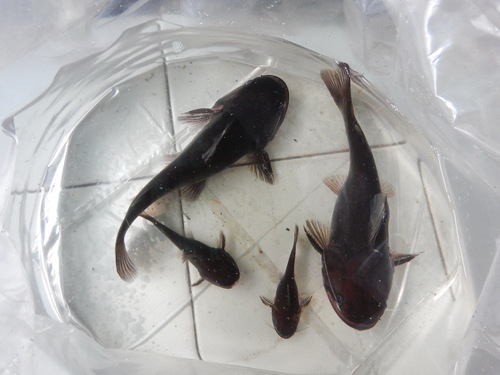
Arapaima Catfish
The Atlantic bluefin tuna (Thunnus thynnus) is a highly migratory, large pelagic fish renowned for its size, speed, and commercial value. It is a top predator in the marine ecosystem and plays a crucial role in maintaining the balance of ocean life. This species is facing significant conservation challenges due to its high demand.
5 15 years
Lifespan
25 cm
Length
Least Concern
Conservation Status
8 km/h
Swimming speed
Carnivorous
Diet
Local Migration
Migration
Appearance Overview
The Atlantic bluefin tuna is renowned for its large, streamlined body, built for speed and endurance. It has a metallic dark blue back and a silvery-white underside.
Coloration
Metallic dark blue on top, silvery-white underside
Body shape
Torpedo-shaped, streamlined
Fins
Two dorsal fins, the first depressible; small finlets behind second dorsal and anal fins
Keels
Small keels present on the caudal peduncle
Length
Up to 13 feet (4 meters), commonly 6.5 feet (2 meters)
Weight
Up to 2,000 lbs (900 kg), commonly around 550 lbs (250 kg)
Diet
Carnivorous, feeding on a variety of fish (such as herring, mackerel, and hake), squid, and crustaceans.
Feeding Behavior
Highly active predator that uses its speed and agility to hunt. They are opportunistic feeders and often hunt in schools, cooperating to herd and capture prey.
Social Behavior
Forms schools, often segregating by size. They are highly migratory, capable of crossing entire oceans.
Commercial Relevance
Extremely high value, especially in the sushi and sashimi markets. It is one of the most commercially important fish species.
Conservation measures
Subject to strict fishing quotas and regulations by international organizations like ICCAT. Marine protected areas and gear restrictions are also in place in some regions.
Status
Endangered
Threats
Overfishing (historically and ongoing), bycatch in fisheries targeting other species, habitat degradation, and climate change affecting prey distribution.
Habitat Distribution
Depth Range
0-1,000 meters (0-3,280 feet), most commonly found in the upper 200 meters (656 feet)
Geographic Range
Western and Eastern Atlantic Ocean, including the Mediterranean Sea. Historically also found in the Black Sea.
Preferred Environment
Pelagic, open ocean environments. They prefer temperate waters but undertake extensive migrations across various temperature zones.
Reproduction and Life Cycle
Breeding Habits
Spawns in two main areas: the Mediterranean Sea and the Gulf of Mexico. Spawning occurs in warm waters, typically from May to July in the Mediterranean and April to June in the Gulf of Mexico.
Development Stages
Eggs are pelagic and hatch within a few days. Larvae are planktonic and undergo rapid growth. Juveniles form schools and gradually move to feeding grounds.
Fecundity
Highly fecund; a large female can produce up to 30 million eggs per spawning season.
Maturity Age
Reaches sexual maturity at around 4-8 years of age in the Mediterranean and 8-12 in the Western Atlantic.
Faqs about Arapaima Catfish
Where are Atlantic bluefin tuna found?
Atlantic bluefin tuna are found in the Atlantic Ocean, ranging from the cold waters of the North Atlantic to the warmer tropical waters of the Gulf of Mexico and the Mediterranean Sea.
How long do Atlantic bluefin tuna live?
They can live up to 40 years, although their lifespan can be affected by fishing pressure.
Are Atlantic bluefin tuna warm-blooded?
Atlantic bluefin tuna are warm-blooded, unlike most fish, which allows them to maintain a higher body temperature than the surrounding water. This helps them survive in a wide range of water temperatures and hunt effectively.
Are they fast swimmers?
Yes, they are among the fastest fish in the ocean, capable of reaching speeds up to 43 mph (70 km/h) in short bursts.
How many eggs does a female bluefin tuna lay?
Females can release millions of eggs per spawning season. The exact number varies depending on the size and condition of the fish.
What is the typical diet of a bluefin tuna?
Atlantic bluefin tuna primarily consume a variety of fish, squid, and crustaceans. Their diet can vary depending on their size and location.
What are the biggest threats to bluefin tuna populations?
The biggest threats are overfishing, due to their high commercial value, and the alteration and destruction of their habitat.
Which organization is in charge of the conservation of the Atlantic Bluefin Tuna?
Several organizations, such as the International Commission for the Conservation of Atlantic Tunas (ICCAT), manage bluefin tuna fisheries and implement conservation measures.
Copyright @ Nature Style Limited. All Rights Reserved.
 English
English